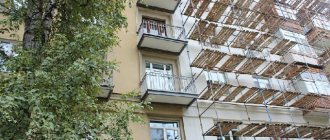What is the difference between a major overhaul and a reconstruction?
When carrying out reconstruction of a building or structure, among other things, they may:
- the conditions for using the facility change;
- some of its elements will be modernized.
That is, such an operation also involves changing the purpose or rebuilding the main structures of the building.
Overhaul is aimed primarily at eliminating the consequences of physical or moral wear and tear of building elements. In this case, no too large-scale work is being carried out. That is, overhaul is a procedure, among other things, less labor-intensive than reconstruction. Moreover, in most cases it turns out to be not so expensive.
Reconstruction and overhaul can be carried out for buildings and structures of any size. The second type of operation can only be performed for individual buildings. Entire architectural complexes are often subject to reconstruction. This allows you to make them more convenient and modern.
For example, in Moscow, in preparation for the 2018 FIFA World Cup, a large-scale reconstruction of VDNH was carried out. Many other architectural objects of the capital were subjected to a similar procedure at that time.
Concepts of major repairs and reconstruction
The first chapter of the Town Planning Code (GRC) gives the concept of these types of reconstruction of buildings.
Important! Reconstruction is the transformation of the main technical and economic data of a structure. Its goal is to change the conditions of use of the object, create new purposes for the building, and compensate for the wear and tear that has occurred not only in physical, but also in moral terms. This concept was introduced by Federal Law number 215-FZ, its 14.1 paragraph. The law was adopted on July 18, 2011.
Overhaul has a different definition. This type of building transformation does not imply a change in the purpose of the structure or individual elements. The appearance and dimensions of the object also do not change. The work is aimed at restoring or correcting wear and tear that has occurred due to physical and moral characteristics. The definition was introduced by the Federal Law of July 18, 2011, number 215-FZ, its 14.3 paragraph.
What work can be carried out during reconstruction
So, we found out what is the difference between a major overhaul and a reconstruction. But what specific types of work can be carried out in both cases? What is changed in a building or structure when, for example, reconstruction is carried out?
This procedure is carried out much less frequently than major repairs and only if it is really advisable. Reconstruction of an old house, for example, may include the following types of work:
- replacement of the main structural elements of the building;
- construction of extensions;
- construction of additional floors, etc.
That is, during the reconstruction process the area of the house or its layout may change.
As for non-residential structures, a similar procedure is carried out using slightly different technologies. But in any case, such buildings are also ultimately subject to serious changes. Bridge reconstruction, for example, may include procedures such as:
- strengthening elements;
- widening of openings;
- extension of supports, etc.
Also, during the implementation of such work, a complete reconstruction of the structure may be carried out. The bridges are being reconstructed, of course, with preliminary design development. Work to remodel such significant structures is financed by government organizations.
Reconstruction of the stadium may include the following activities:
- organization of the necessary relief;
- installation of heating systems;
- arrangement of drainage;
- watering device.
In addition, the contractor can also perform such type of work as installing artificial lighting.
Major renovation. What is this?
This is a type of work in which the object is restored to current standards and standards. It is also important here to replace any parts of the construction project if necessary.
Major renovations in the Town Planning Code
A major overhaul is a complete replacement or partial restoration of elements of a construction project (except for the replacement of load-bearing structures), replacement or restoration of systems and networks of engineering equipment, replacement of some part of the load-bearing structures with the same ones or those that can improve existing performance.
This is important to know: Is it possible to return mortgage insurance?
Major repairs of linear objects - repair of roads, railways, overpasses, that is, those objects whose length greatly exceeds their width. This is a complete or partial change in existing parameters, but which does not change their category or class, as well as the original indicators and characteristics. Here, too, there is no need to change the boundaries of the right of way and their protection zone.
From all of the above, it becomes clear that major repairs do not change the technical indicators of the object (does not increase or decrease its area, etc.).
What is a capital construction object and a linear object?
Capital construction projects mean any buildings, structures, structures, as well as those objects that have not yet been fully built. This does not include temporary structures, stalls, etc. In addition, the construction objects may not be all buildings, but parts of them, for example, a roof, a wall, etc.
Linear construction objects, as mentioned earlier, are various types of heating networks, pipelines, railways, roads, bridges. Here a major overhaul of the entire roadway or part of it can be carried out.
Major renovation of buildings. What does it include?
This type of repair work is carried out if the building is worn out or some part of it has begun to collapse. Here the main goal is to restore or completely replace part of the building.
Why is a major overhaul needed?
The main goal is to remove all defects that interfere with the normal functioning of the building, replace or partially restore its parts, and also strengthen the load-bearing structures, foundation, and roof. If replacement is needed, it is carried out using more advanced materials and technologies.
Major renovation. What is it like?
This type of construction work is divided into two types: comprehensive and selective repairs. Comprehensive overhaul is a type of work in which important elements and utilities are replaced in order to improve them. With such repairs, the entire building or some parts of it are subject to change. Here it is important to completely eliminate physical and moral wear and tear.
Selective overhaul is a type of work in which the complete or partial replacement of elements of buildings and structures occurs. Here, too, it is important to completely eliminate moral and physical wear and tear.
Overhaul work
Reconstruction of squares, stadiums, buildings is, of course, a very complex and expensive task. During major repairs, relatively expensive work is also often carried out. However, in this case, the building or structure ultimately does not undergo any large-scale changes. For example, the following types of work can be carried out during major repairs:
- repairing leaking roofs;
- repair or replacement of various types of utilities;
- improving the appearance of a building or structure;
- foundation or wall repairs.
In some cases, during major renovations, the building may be additionally insulated.
Related terms
Let's consider such a concept as modernization, which in the Urban Planning Code means improving the technical indicators and characteristics of any objects due to the replacement of systems or significant elements with more advanced ones.
Modernization can be carried out during major repairs of buildings and structures: replacing worn-out heating systems with newer and more technologically advanced ones, which are less likely to be exposed to temperature changes; You can also improve outdated load-bearing partitions and replace them with high-quality ones that are durable.
The same actions can be performed with linear objects. As is already known, during major repairs there is no increase in road lanes, and the power and pressure of utility lines does not increase. But here it is possible to replace the road surface with a higher quality and wear-resistant one, install high-quality polypropylene pipes instead of the old cast iron tracks from the times of the “Soviet Department”.
Technical re-equipment is a complete change in the entire technological process. Redevelopment - this type of activity can be used only when it is necessary to change a significant (structural) part of a building or structure.
This is important to know: How electricity is turned off for non-payment and what to do after the shutdown
Concept of reconstruction
Now the term reconstruction is often found in the Housing, Tax and Urban Planning Codes.
The term reconstruction in the Town Planning Code
Reconstruction of objects (except for linear objects) implies the parameters and characteristics of capital construction objects or some of its individual parts (increase or decrease in height, number of floors of buildings and structures, total area or volume).
This also includes additional extensions to existing buildings, changes in its configuration, redevelopment or complete restoration of load-bearing parts and elements. The exception is the replacement of any parts with the same ones or those that can exceed the current performance.
For example, the object of reconstruction can be various types of buildings (residential and non-residential) and so on.
Reconstruction of linear objects (utility networks, highways, railways, etc.) implies a complete change in its existing characteristics. In the course of this type of work, the classification, category or its initial parameters completely change. Here it is also necessary to change the boundaries of the object and its protected area. For example, the object of reconstruction may be the water supply system, gas supply and other types of utilities.
The concept of reconstruction in other sources
In the Tax Code of the Russian Federation, the term reconstruction is deciphered as a complete modification of buildings and structures aimed at re-equipping production processes with the obligatory improvement of its technical indicators. The purpose of such events is to improve the quality of products and increase their quantity. To do this, it is also imperative to increase the production capacity of the enterprise.
From all of the above, it has become clear to many that the terms “reconstruction”, as interpreted in the Tax and Urban Planning Codes, carry completely different meanings. Then the question arises: what concept still needs to be used to accurately describe processes?
Here you need to understand that the concept of “reconstruction” is completely absent in the Housing Code. Instead, experts use the concept of “reconstruction,” which is interpreted here as a major overhaul (replacement, restoration of some parts or elements of construction projects).
Now we will try to explain why the term “reconstruction” in the Tax Code is so different from the Housing and Urban Planning Codes. According to the Tax Code, all terms and concepts used by it have the meaning and meaning that individual sectors have (civil, family and others).
In other words, it turns out that if an enterprise has its main goal - the production of products that should be taxed, then the term “reconstruction” from the Tax Code must be interpreted directly. It turns out that here reconstruction means a complete replacement or modernization of current equipment, with the help of which it is possible to produce completely different products (newer), or increase the volume of its production or significantly improve the quality. But if you still need to replace morally or physically worn-out equipment with completely new and high-quality equipment, then this will be considered technical re-equipment.
In this case, you can change the production technology, but you cannot at all increase the existing production capacity, improve the quality of the products and increase their volume.
Do I need to get permission?
The difference between a major overhaul and a reconstruction lies, therefore, primarily in the scale of the work. But owners, for example, of private country houses, in any case, often perform both of these operations independently. Do I need to obtain permission for any changes to a private building?
Major repairs of any building, including low-rise ones, as a relatively simple operation, can be done without first visiting any institutions. Another thing is reconstruction. Events of this type are always a responsible procedure. And this concerns not only, for example, the reconstruction of VDNKh or even just any industrial building. Remodeling even a small building requires drawing up a project and serious investments.
Reconstruction of a private house is, of course, a very important event. In our country, any owner has the right to use only that part of the building that is officially registered as his property. Replacing any structures of a house can lead, for example, to its destruction. And this, in turn, often causes inconvenience to neighbors. An increase in the area of the house may also be associated with a violation of the rights of the owners living nearby.
Therefore, according to the Civil Code, it is mandatory to obtain permission to reconstruct a private house. Such a document will be required if the building is located on a site allocated:
- for individual housing construction;
- for low-rise construction;
- for running personal farming.
No permits are required for the reconstruction of garden houses and dachas.
Reconstruction of buildings
This is a broad concept, which is specified in the Town Planning Code of the Russian Federation, in part of Article 1, paragraph 14. According to the provision, this is a constructive change in the main load-bearing parameters of the building that affect load-bearing structures. This category includes redevelopment, superstructure, expansion, and reduction of area. Anything related to changes in the structural elements of a building or premises can be classified as reconstruction.
A distinctive feature from capital repairs is that it is necessary to have approval for the reconstruction of a capital construction project. Thus, there is a single rule for all participants and owners of construction and repair work - reconstruction requires documentary evidence of the beginning of such a process.
However, there is still a discrepancy, which is enshrined in the Tax Code of Russia, where reconstruction for some reason is called reorganization. At the same time, the very concept of reconstruction combines both elements of major repairs and aspects of reconstruction of buildings.
At the same time, officials from various departments argue that only the Housing and Town Planning Code correctly interprets the concept of major repairs and reconstruction of premises, while some aspects of the Tax Code may be applicable to these concepts, but only partially.
How to obtain permission for reconstruction
Owners of country houses who decide to carry out such a reconstruction should first contact the BTI and obtain a copy of the cadastral plan, as well as technical documentation for the building. Then you need:
- take the received papers to the Architectural Department and write a corresponding application;
- wait for the arrival of the architect who will draw up a reconstruction project;
- bring the finished project to the Architectural Department;
- wait until permission for reconstruction is received.
At the final stage, the owner of the building will also need to visit the SES and the Ministry of Emergency Situations. If the reconstruction involves the replacement or installation of any communications, you may also have to obtain permission from the utility or gas service.
What might a major overhaul include?
The difference between a major overhaul and a reconstruction, among other things, lies in the cost of the work. Owners of private low-rise buildings carry out large-scale changes relatively rarely and only if they have sufficient funds. Reconstruction of an old house may include, for example, such activities as the construction of an extension, the arrangement of a residential attic, etc.
Major repairs of low-rise country buildings are not too cheap either. Owners of private houses also carry them out only as needed, but still more often than reconstructions.
In the city, such work is carried out according to the program of capital repairs of houses. The private owner himself decides when to carry out such a procedure. But in both cases, almost the same types of work are performed. In a private home, major renovations usually include the following steps:
- development of a work plan;
- replacement of doors and windows;
- roof and floor repairs;
- renovation of the facade.
Redecorating
When the task is simply to “refresh” old renovations in an apartment or house, it is most reasonable to focus on the “cosmetics” option.
Cosmetic repairs are also used to maintain the operational qualities of residential premises, by restoring the protective properties of the materials used and eliminating minor damage during the work.
Simple cosmetic repairs are carried out without replacing various types of finishing - wallpaper, painting walls and ceilings, doors and windows, baseboards and trim. It also does not provide for updating the floor surface with varnish or paint.
In contrast, cosmetic repairs with the replacement of finishing materials are aimed at restoring a room that has lost its attractiveness, and involves the purchase and use of new finishing materials - the same wallpaper, linoleum, carpet, paints and varnishes.
Unlike expensive major repairs, cosmetic repairs do not involve remodeling of premises, installation work, replacement of electrical wiring and plumbing, and other complex work.
How do you know if your home needs a facelift?
The need for repair work is usually assessed based on the following criteria:
Condition of the ceiling, slopes and walls
If cracks or stains appear on the ceiling, but they are small, and the ceiling itself is smooth, it will be enough to make cosmetic repairs. Thanks to it, you can effectively hide problem areas and visual imperfections.
If there are uneven spots on the ceiling, you can also “play” with the light. A well-known technique is when replacing the lighting and chandeliers in the room helped hide this defect.
With walls it is more difficult, especially if we are talking about cracks not in the wallpaper, but in other materials. In this case, if you don’t want to do a major overhaul, these places can be covered with some interior element: hang a picture, a mirror, or install a bookcase.
The uneven slope that appears after replacing the window can be draped or hidden with new curtains.
Floor and coating condition
The floor may look bad. But something else is more important: if you don’t hear a squeak, the integrity of the coating is preserved and the surface is fairly smooth, there’s no need for major repairs, it’s enough to do “cosmetics.”
If you no longer like your floor, you can simply lay linoleum and put a soft carpet on top - this will make the room much more comfortable. You can also use carpet instead of linoleum. This material will effectively hide imperfections and unevenness of the floor, and also fill the rooms with warmth and comfort.
Window
Experienced apartment and house owners know very well all the pros and cons of old windows. And of course, a major overhaul is absolutely unnecessary here.
If there are cracks in your windows, they rattle and provide poor protection from noise, consider ordering and installing plastic windows. They are characterized by: maximum noise insulation, hermetic closure and ease of operation and maintenance.
Although many people don’t like plastic windows. Some because of the price, some because of their (allegedly) non-environmental friendliness. Then all that remains is to repair the old wooden frame. All you need for this is a can of paint, a solution to remove old paint, putty to eliminate unevenness on the surface of the frame and sandpaper to clean the surface.
Doors
If the doors have lost their presentable appearance, they do not have to be replaced immediately. You can try painting and varnishing.
Sale of land on the Cape near the Volga 88 acres, 165 km from the Moscow Ring Road VIEW
Design tricks
Recently, it has become fashionable to use mirrors in design. They visually enlarge the space, fill it with light, but most importantly, they can hide some defects in the floor and walls.
If your ceiling has imperfections, it is not recommended to hang a large chandelier, as the bright light will make everything visible. It is optimal to install the light source on the wall, while providing warm, not too bright light.
If you have replaced windows, it is better to hang light tulles and put brightly colored pillows on the sofa. With this design technique you will concentrate attention on the advantages (volume, natural light) rather than the shortcomings of the room.
Replacement of windows and doors
An urgent need for major repairs may arise, for example, when frames and jambs dry out, rot or crack. Replacing windows in most cases involves carrying out procedures such as:
- dismantling sashes and frames;
- taking measurements;
- production or purchase of new windows;
- installation of windows in openings.
Doors in country houses are also replaced using approximately the same technology. In most cases, plastic windows are chosen for concrete, brick or monolithic country buildings. In log, panel or log houses, wooden double-glazed windows are installed.
Roof repair
This operation is carried out during a major overhaul of a private house if the roof begins to leak. The cause of this problem is usually rusting or damage to the roofing material. In this case, when performing major repairs, the problematic part of the roof covering is first dismantled.
At the next stage, the condition of the roof “pie” materials in the leakage area is checked. If necessary, partial replacement of the thermal and waterproofing insulation is carried out.
The line between reconstruction and major repairs
According to the definitions of these concepts, the difference lies in the number of replaced structural elements.
Major repairs - replacement of part of the supporting structures or their individual elements. De jure, when 99% of the beams are replaced, we can say that this type of work is a major overhaul. Thus, you will not need to develop a full set of design documentation in accordance with the Decree of the Government of the Russian Federation No. 87, obtain a construction permit and put the facility into operation.
Wooden floors in the building
The need to repair the floor in a country house usually arises when the covering begins to creak or sag. Rotting of boards or destruction of concrete screed may also cause the need for corrective work.
When renovating an old house, wooden floorboards are replaced using approximately the following technology:
- They tear down the old board. When removing ordinary boards, in most cases only a nail puller is used as a tool. When dismantling tongue-and-groove floorboards, use a hacksaw to cut off the lock protrusion.
- New floorboards are being installed. When performing this operation, try not to leave gaps between the boards. At least two nails are driven into each installed floorboard above the joists.
Sometimes the floorboards themselves in a country house remain intact, but at the same time they begin to wobble. In this case, experts advise simply replacing the nails in the floorboards with screws for repairs.
Major repairs in construction
A fashionable and prestigious word used in construction today is the overhaul of real estate. But, if you ordered the reconstruction of capital construction projects, remember that major repairs are not the same thing, as many people think about it. According to the Town Planning Code of the Russian Federation, there is a definition of such a plan that when carrying out major repairs, any replacement or restoration of structures is carried out, but this does not provide for the replacement, demolition or renovation of load-bearing structures and elements that may have a role in the viability of the building.
Figuratively speaking, a major overhaul in itself involves any construction work, but the load-bearing structures of the building cannot be demolished or moved. If this is violated, then you may be subject to fines, and in case of destruction with serious consequences, you may be subject to criminal liability. The principle of overhaul applies only to OKS. For linear objects, the concept of major repairs has a completely different meaning.
Capital construction projects as independent building objects include the following categories of structures, buildings, structures:
- All categories of buildings.
- All categories of capital buildings.
- Unfinished construction projects.
- Residential and non-residential objects.
- Apartment buildings.
- Local area.
In addition, it is not intended to recognize kiosks, temporary buildings, buildings with a self-disassembling principle, canopies, etc. as OKS. Each of them has its own characteristics, which indicate that the temporary status does not allow identifying the object as permanent. This category also includes garages that can be easily moved to another location, for example, the “shell” type.
Linear objects include pipelines, main roads, power lines, bridges, engineering structures, and some categories of monuments. In this case, major repairs of the OKS are not applicable for such facilities.
There are two categories of major repairs, these are selective and also comprehensive. Selective repairs involve the replacement and repair of certain elements. For example, the building will undergo renovation of several rooms and a flight of stairs. Comprehensive repairs cover the replacement of structural parts of the entire structure, but replacement of load-bearing structures is not allowed, as is the case with selective overhauls.
Concrete screed repair
Of course, most often floors in country houses are installed from boards. But sometimes such buildings also have concrete coverings. Damage to the screed may include the following:
- cracks;
- potholes;
- detachment.
Cracks usually appear at the point of greatest tension in the coating. Repair in the presence of such damage is carried out using approximately the following technology:
- the cracks widen and deepen slightly;
- along the entire length of the cracks, perpendicular notches are made 15 cm long and 2 cm deep;
- dust is cleared;
- metal rods are placed in the cross sections;
- The cracks and cuts are sealed with a concrete mixture.
Potholes in the screed are repaired as follows:
- cut a hole along a rectangular perimeter to the full depth;
- remove concrete residues from the recess;
- cover the pothole with concrete mixture.
When repairing screeds, delaminations are usually completely cut out and sealed with cement mortar.
Renovating the facade of a country house
Reconstruction of objects can sometimes include a procedure such as replacing or rebuilding walls. When performing major repairs, attention is usually paid mainly only to the appearance of the facades. The choice of method for updating the exterior of a private low-rise building depends on what material it is built from.
In most cases, when performing major repairs, the walls of country houses are finished using:
- curtain facades;
- decorative plaster.
When finishing a building, it is usually also insulated.
Installation of a curtain facade
In this case, mineral wool is usually used as insulation. Finishing the building cladding can be done using:
- siding;
- profiled sheet;
- clapboard or blockhouse, etc.
The installation of curtain facades is carried out using approximately the following technology:
- the walls of the building are covered with a vapor barrier;
- timber lathing is attached to the facades;
- mineral wool slabs are installed between the beams;
- strips of polyethylene film are attached on top of the heat insulator using not too thick bars;
- The finishing material is fixed on the bars.
Mineral wool slabs are installed between the sheathing beams without additional fastening. In cold regions, this material is usually mounted on walls in two layers. At the same time, when installing the upper slabs, make sure that the joints between them do not coincide with the joints of the lower layer.
Siding and corrugated sheets are attached to the bars using self-tapping screws. To fix the lining or block house, special hidden elements are used - clamps.
Plastering
When using this technique, the facades of the building also end up being quite attractive and look modern. Before plastering, houses are in most cases pre-insulated with polystyrene foam.
Sheets of this material are attached to the walls using special glue. Additionally, polystyrene foam is fixed to the walls using plastic dowels. Upon completion of the insulation work, the facades are covered with reinforcing fiberglass mesh.
Next, they begin the actual plastering. In order for the walls to look neat, they use the beacon finishing method. For rough plastering, moisture-resistant cement mortar with special additives is used.
At the next stage, the walls are covered with a layer of decorative plaster. Next the house is painted. In this case, they use products designed specifically for finishing facades on the street side.







